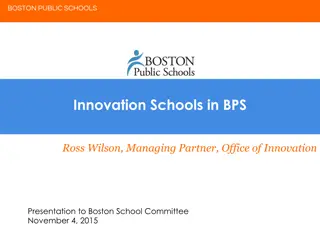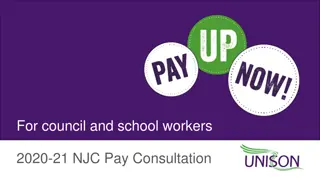UNISON Schools Survey 2017: West Sussex Funding Crisis and Impact of Restructure
The UNISON Schools Survey conducted in 2017 in West Sussex revealed a funding crisis affecting schools, with over 500 responses indicating an increasing rate of restructuring. The survey highlighted that a significant percentage of respondents, including UNISON members, support staff, parents, and teachers, had been through or were uncertain about restructuring, mainly driven by financial reasons. The impact of the restructure included lowered morale, increased workload, stress, and a sense of greater responsibility among those affected.
Download Presentation

Please find below an Image/Link to download the presentation.
The content on the website is provided AS IS for your information and personal use only. It may not be sold, licensed, or shared on other websites without obtaining consent from the author.If you encounter any issues during the download, it is possible that the publisher has removed the file from their server.
You are allowed to download the files provided on this website for personal or commercial use, subject to the condition that they are used lawfully. All files are the property of their respective owners.
The content on the website is provided AS IS for your information and personal use only. It may not be sold, licensed, or shared on other websites without obtaining consent from the author.
E N D
Presentation Transcript
UNISON Schools Survey 2017 West Sussex Funding Crisis
Responses and indication of an increasing rate of restructure There were over 500 responses to the survey 45% respondents have been through a restructure with a further 38% unsure Almost half, 46.8%, said the restructure had taken place in the last year against 28% in the previous year. This suggests an increasing rate.
Who were the respondents? 76% of respondents were UNISON members 48% Support Staff 27% Parents 10% Teachers 2% Heads, Governors, Business Managers
Over 80% said the restructure was financially driven Schools in West Sussex receive 200 per pupil less than the national average. Worth Less? campaign demanded 20m from government in transitional funding, refused. New national funding formula delayed until 2018-19
Other than staffing, the survey asked what other savings had Other than staffing, the survey asked what other savings had there been? there been? Resources 88% Equipment 85% Buildings 33% Heating / ventilation 14% Transport 13%
On the diminishing resources, one member said Due to lack of funding there are limited resources and many resources that are available are very tired and worn.
Do you feel the process was managed well? This should include support from management, proper consultation and selection for alternative roles? Only 36% say the process was managed well. 27% say the process was not managed well. 36% say the process was ok. UNISON is concerned about the worsening support from central services.
We asked respondents what impact the restructure had on them As a result of the restructure: 65% said it had lowered morale 44% said it had contributed to stress / health problems 48% said it had resulted in them having greater responsibility 78% said they had experienced increased workload
We asked respondents what impact the restructure had on them We asked respondents what impact the restructure had on them Reduction of SNTAs means I have to support special needs children in the class as well as keeping up with my usual role Although few were made redundant, many left because of the stress The role is poorly paid, frequently challenging and pay rises derisory many colleagues openly discuss a desire to seek alternative employment and express low levels of satisfaction regarding, pay and conditions
The survey asked how many job losses there had been due to restructure 80% said between 0-5 job losses 16% between 5 10 Almost 3% said more than 20 Less staff means more work for everybody who remains.
We asked if the number of staff needed to do the work had been impacted 73% said that the number of staff needed to do the work was worse since the restructure. UNISON is concerned about the gradual erosion of support staff in our schools. These staff provide much needed support to the most vulnerable children.
As a result of the restructure, has the number of staff needed to carry out the work in your school improved or got worse? One Headteacher said: Everyone is stretched to the limits. In a school of social deprivation we are unable to offer the support to children and their families of previous years.
As a result of the restructure, has the number of staff needed to carry As a result of the restructure, has the number of staff needed to carry out the work in your school improved or got worse? out the work in your school improved or got worse? Some year 11 GCSE English classes were taught by unqualified support staff last academic year. Staff feel that the quality of work they do has dropped as you don't have the time to do the job properly. You just rush- rush-rush Classes have had to become mixed year groups across Y1/2 and Y3/4 due to lack of funding The work is still there, but it does not get done in a timely manner or sometimes at all
UNISON asked respondents about the impact on educational outcomes for children 47% said educational outcomes in their school had got worse as a result of a restructure Much worse for children with additional needs, and worse for all our children as a result
Impact on educational outcomes Impact on educational outcomes There not enough qualified teachers, enough resources and in general the means to provide better educational outcomes for our Children. Class sizes are too large, especially for lower ability pupils. Teachers are massively overworked and we are no longer able to give the support they need as there are too few of us. Statement hours not being met. All SEN pupils suffering
We asked respondents whether there was an increased safeguarding risk as a result of restructure 31% said they thought there was an increased risk to safeguarding as a result of restructure. Less of our members on the ground means a greater risk for children in schools. This was reflected in the responses.
Impact on safeguarding Impact on safeguarding At lunchtimes there are insufficient staff to cope with the volume of children. If support staff are used instead of a permanent teacher giving a stable environment for learning, then safeguarding issues can be overlooked. There is little understanding or allowances made for the fact that we have high numbers if very young children and therefore need to maintain high ratios to maintain safety Less staff means fewer people are looking out for the vulnerable students.
We asked respondents what they thought the impact of the restructure was on SEN provision 65% say special educational needs (SEN) provision has got worse as a result of restructure in their school This is a shocking statistic. The most vulnerable are those most likely to suffer as a result of cut-backs.
Impact on SEN Impact on SEN Dedicated SEN HLTA now not being used for her specialism. Some days we can now only cover statemented students, and assistant presence in smaller classes has also dropped. There are now less staff to support children with additional needs. This has an impact on all the children we work with, not just those with additional needs. When I started in 2007 there were over 10 LSAs now there are 6 of whom 2 are full time.
As a result of the restructure has Special Educational Needs (SEN) provision got better or worse, in your view? One Headteacher said: We have had to significantly reduce our intervention support, our numbers counts teacher is back in class and our high need children are receiving fewer hours support.
We asked respondents to comment on the perceived risk to the health and safety of staff and children, as a result of restructure... 51% say there is now a greater risk to the Health and Safety of staff, children and other stakeholders Taken together with cuts to equipment, heating etc, UNISON will press for more robust risk assessment.
We asked respondents to comment on the perceived risk to the health and safety of staff and children, as a result of restructure... One Parent said: There are always going to be increased Health and Safety risks for everyone involved, when class sizes are forced to increase.
Impact on Health and Safety Impact on Health and Safety Hopefully high standards will remain but it is hard work. Stress will lead to sickness In certain subjects the numbers are too high, especially in more difficult classes, which make practical components more of a risk Stressed and overworked staff increases the risk of mistakes being made.
There is no doubt our school and the opportunities for our children would improve with equal government funding; fair and equitable for our school and others in our part of the country























